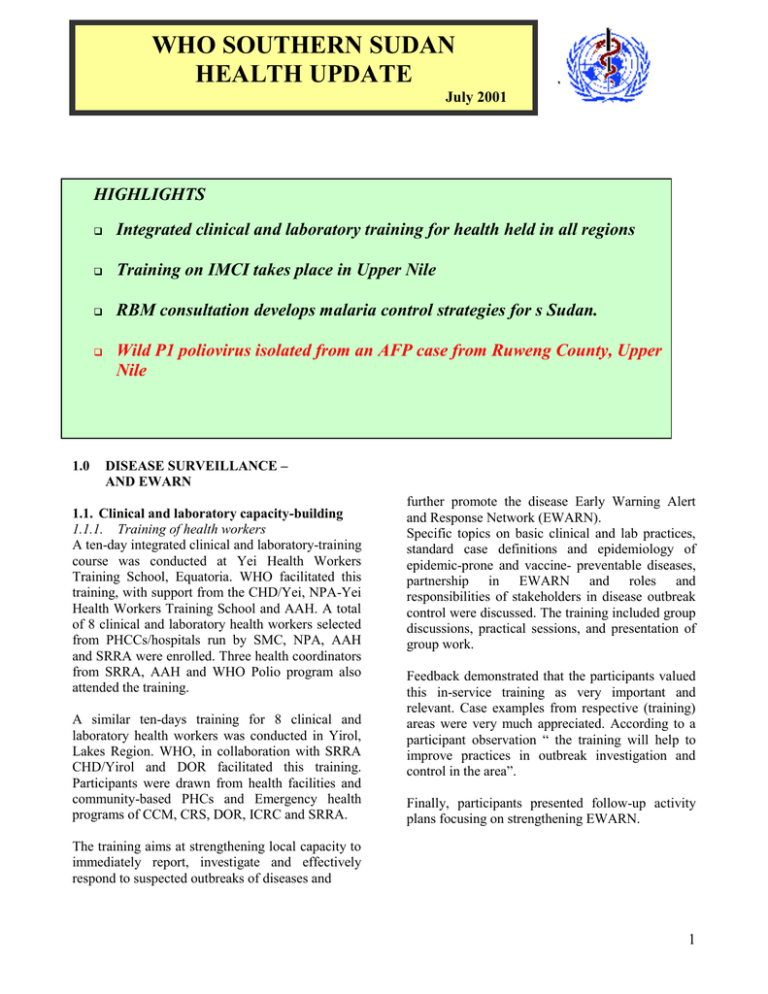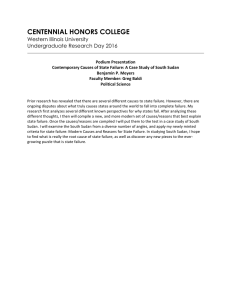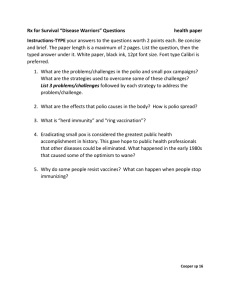1.0 DISEASE SURVEILLANCE – AND EWARN
advertisement

WHO SOUTHERN SUDAN HEALTH UPDATE July 2001 HIGHLIGHTS Integrated clinical and laboratory training for health held in all regions Training on IMCI takes place in Upper Nile RBM consultation develops malaria control strategies for s Sudan. Wild P1 poliovirus isolated from an AFP case from Ruweng County, Upper Nile 1.0 DISEASE SURVEILLANCE Integrated clinical and–laboratory AND EWARN training focusing on surveillance, response and EWARN covers more areas further promote the disease Early Warning Alert 1.1. Clinical and laboratory capacity-building and Response Network (EWARN). 1.1.1. Training of health workersencouraging and provides Outbreak response: response Specific lessons topics on for basicoptimal clinical and lab practices, A ten-day integrated clinical and laboratory-training standard case definitions and epidemiology of course was conducted at Yei Health Workers epidemic-prone andworkers vaccine- preventable diseases, AFP surveillance training reaches to front-line health Training School, Equatoria. WHO facilitated this partnership in EWARN and roles and training, with support from the CHD/Yei, NPA-Yei responsibilities of stakeholders in disease outbreak Health Workers Training School and AAH. A total control were discussed. The training included group of 8 clinical and laboratory health workers selected discussions, practical sessions, and presentation of from PHCCs/hospitals run by SMC, NPA, AAH group work. and SRRA were enrolled. Three health coordinators from SRRA, AAH and WHO Polio program also Feedback demonstrated that the participants valued attended the training. this in-service training as very important and relevant. Case examples from respective (training) A similar ten-days training for 8 clinical and areas were very much appreciated. According to a laboratory health workers was conducted in Yirol, participant observation “ the training will help to Lakes Region. WHO, in collaboration with SRRA improve practices in outbreak investigation and CHD/Yirol and DOR facilitated this training. control in the area”. Participants were drawn from health facilities and community-based PHCs and Emergency health Finally, participants presented follow-up activity programs of CCM, CRS, DOR, ICRC and SRRA. plans focusing on strengthening EWARN. The training aims at strengthening local capacity to immediately report, investigate and effectively respond to suspected outbreaks of diseases and 1 1.2. EWARN Advocacy Workshops and Surveillance 1.2.1. Community-level workshops continue WHO, in collaboration with SRRA/Yei and CHD/SRRA, organized a two-day community-level sensitization/orientation workshop on EWARN and disease outbreaks surveillance and response in Yei, Eastern Equatoria. There were a total of 35 participants from five payams, composed of teachers, opinion leaders, church and women groups and local counterparts. The training focused on epidemic surveillance, investigation, response and the role of the community in reporting of suspected/rumors of outbreaks. Simplified community-level case definitions on selected diseases/syndromes and steps to assist the community in reporting of outbreak were discussed. Guidelines were distributed to those who could read English. 1.2.2. NGOs consultation to strengthen partnership A one-day follow-up consultation with NGOs on strengthening outbreak surveillance and EWARN was conducted in Akobo, Upper Nile. Discussions were held on the EWARN, and the roles of health and other development and relief NGOs in outbreak surveillance and response. MSF-B, VSF-B, PRDA, RDC and WHO participated. Similarly, a one-day consultative meeting was held with 8 NGOs and counterparts in Yei, Eastern Equatoria. AAH, IAS, Malteser, NPA, SMC, CHD/Yei, SRRA/Yei and WHO attended. The participants were briefed on EWARN. Participants pledged to strengthen partnership among NGOs, communities and WHO. 1.2.3. Consultation on measles/TT campaign WHO actively participated in UNICEF/OLS coordinated consultations, planning, and community training activities held at Billing, Yambio and Yei. The measles coordinator (UNICEF) and the polio coordinator (WHO) also traveled as a team through Yambio, Maridi and Mundri. 1.3. Consultation on Roll-Back Malaria (RBM) A total of 21 NGOs operating in southern Sudan participated in a one-day consultation. Loki. The meeting was organized by WHO EMRO (Drs Guido Sabatinelli and Atta Hoda) WHO HQ (Dr Claudio Baltrimello) and WHO s Sudan. Visits were also made to key partners in Nairobi and Loki by the team. The consultations identified partners’ activities, challenges and opportunities for the malaria control effort in southern Sudan. Partner organizations are ready to actively participate in RBM efforts Health service data from southern Sudan show that malaria is among the leading causes of health service visits, and seasonal outbreaks occur in different areas. The four key interventions that can be effective in the complex emergencies prevailing in southern Sudan were discussed in detail. These main interventions are Early detection and adequate treatment, Presumptive intermittent treatment in pregnancy (PIT), Use of insecticide treated materials (ITM), surveillance and epidemic preparedness and response. Consensus was reached on roles of WHO, NGOs and local partners in enhancing RBM. 1.4. IMCI Training Continues WHO, in collaboration with CCM and MSF-B, conducted an eight-day training on Integrated Management of Childhood Illnesses (IMCI) at Akobo, Upper Nile. This included the training of 2 supervisors/facilitators, followed by the training of 10 CHWs. The training focused on improving skills on “ Essential Community Child Health Care”. The training will contribute to reduce the burden of excess illness and death from common childhood illnesses (among under-5 children). 2 2.0 POLIO ERADICATION 2.1 Wild P1 Poliovirus Isolated from Ruweng County available, the nurse had to use a plastic bag that she found in the vicinity. 2.1.1. Background 2.1.3. Patient Information The patient is a 2 year old female originally from Akotweng village in Kueldit Payam, Ruweng County, Western Upper Nile. At the time of onset of paralysis, the family was living in the toich (wetlands) area approximately 2-3 hours walk from Padit village (location of airstrip). The family had moved to the toich in January 2001 for the dry season (January-May). This toich area is highly populated during the dry season. During an upcoming mission to Ruweng County, more information will be collected concerning the child’s movement during the months preceding and following the onset of paralysis. On Monday, 23 July 2001, the WHO-south Sudan office received intra-typic differentiation (ITD) results from the National Institute of Virology (NIV) laboratory in South Africa on a pending Acute Flaccid Paralysis (AFP) case. The results, based upon analysis of a single stool specimen, confirmed the isolation of a P1 wild poliovirus. This is the first P1 wild poliovirus that has been isolated from southern Sudan since the start of the polio eradication programme in southern Sudan in 1998. P3 wild poliovirus was isolated from stool specimens from one AFP case from the Bahr el Ghazal region of southern Sudan in 1999. In 2000, P1 wild poliovirus was isolated from stool specimens from 4 AFP cases in north Sudan, however, it is too early to determine if the recently isolated P1 from Ruweng County is related to the viruses isolated from these 4 cases. Geno-typing of the virus is underway to determine if a relationship exists. 2.1.2. Case Investigation The case presented to the medical assistant for Padit, Ruweng County, who then reported the case to the MedAir mobile team on 14/05/01. MedAir was to be on ground in Ruweng County for a total of 6 days in May 2001 for a seeds and tools distribution—the case was reported on the day before MedAir was to leave the area due to insecurity. MedAir immediately contacted the WHO sub-Office in Lokichokkio, Kenya, to report that an AFP case had been referred to their team on ground and that they would require icepacks and a vaccine carrier in order to collect stool specimens, as well as a case investigation form. The WHO Surveillance Medical Officer had just previously briefed (MedAir in Loki.) The following day, 15/05/01, the cold chain items arrived on a chartered flight, so MedAir proceeded with the investigation. The investigation and stool collection was done by a nurse/mid-wife that was on her first mission into southern Sudan—this was also her first experience with investigating a suspected polio case. As it was necessary for the MedAir team to evacuate the area that same day, it was only possible to collect one stool specimen instead of the standard 2 specimens 24 hours apart. Also, as there was not a stool collection kit The onset of paralysis date is set at 24/04/01 and reportedly similar paralysis cases were also existent in the village/toich of onset. Fever at onset of paralysis was reported. Paralysis was observed in both the left and right legs. Although the parents originally reported that the child had been immunized, upon further investigation, it was determined that the child had never received any doses of OPV. 2.1.4. Ruweng County Ruweng County is located on the northern part of the Kir/Bahr-El-Arab River. The county is bordered to the south by Liech (Unity) and Phou States, to the north by the Nuba Mountains and to the east by Shilluk Kingdom (Fashoda). The northeast, west and northwest of Ruweng County are Government of Sudan (GOS) areas. The community living in the county is Dinka. Due to ongoing insecurity, Ruweng is the only county accessible to OLS where WHO has been unable to establish a polio eradication infrastructure—i.e. there is no surveillance staffing on ground. One round of NIDs was conducted in 1999 and two rounds in 2000—due to large population movement and unreliable population data, it is difficult to determine exactly how successful these campaigns were. However, in 2000, according to the estimated target population, the NIDs coverage was reported as 111% and 235% for 1st and 2nd rounds respectively. No immunization has been done in 2001 due to inaccessibility. Ruweng County has five payams (districts), with an estimated total population of 64,000 (therefore, an under 5 years population of approximately 12,800). 3 There is a lot of population movement in the county during the dry season due to a shortage of water. Most people move to the Padit area, which is a place where they can get fish, water and grazing land for cattle. The movement to Padit starts in January each year. During the rainy season, people return to their villages for cultivation. It is suspected that the family of the positive case has moved back home by now. 2.1.5. Plan of Action A more thorough epidemiological investigation is immediately required. The primary objectives of the investigation are to 1) know where the virus has been circulating without detection for at least 10 months (particularly if this is the same strain that was the last isolate from all of Sudan in July 2000 in White Nile State), and 2) to assess which areas may be presently infected, and 3) which areas to target in a mopping up response. This will be accomplished through: 1. Thorough analysis and review of existing AFP surveillance data, especially in states/areas in and around Upper Nile (both in OLS and GOS areas). Focusing on quality of surveillance, silent or gap areas, areas with clustering of AFP or clinical polio cases. 2. Getting the word out quickly far and wide to enhance surveillance activities, especially immediate case reporting, active surveillance, and immediate investigation of any cases detected. 3. Thorough investigation of the index case, especially regarding travel and contact history before and after onset of paralysis and collection of stool. 4. Focusing investigation and surveillance efforts on areas, particularly relatively densely populated towns or large villages on travel routes, where the case may have been and villages located around the village and county of paralysis onset. 5. Focusing attention to areas that have not been accessed by immunization teams for many months. Eight WHO polio staff are presently on ground in Ruweng County. They will split into 3 teams on ground and move in different directions on foot. In addition to the epidemiological investigation detail above, in all locations the staff will be mobilizing the communities and developing microplans in preparation for a 3-round polio immunization campaign for all children under 5 years of age. 2.2.6 Implications on polio eradication in south Sudan This case highlights again the importance of surveillance in ensuring that south Sudan is free from Polio. The area is one where neither the north nor the south has full access. The instability in Sudan is currently the most significant factor affecting eradication activities. GOOD SURVEILLANCE AND REACHING ALL CHILDREN IS CRITICAL FOR POLIO ERADICATION 2.2 Martin Odera recognized as a Polio Eradication Hero On 22 October 2000, Mr. Mark Odera from Parajok, Torit County had breakfast with his family of 2 wives and 6 children and proceeded to the Payam Headquarters to present second round SNIDs results to the payam polio field assistant. That was the last time his family and friends saw him alive. After submitting the results at 10.00 am, Mark started walking back to the village together with the local authority secretary. They heard the sound of a high flying aircraft, and as they had no time to run to the nearest bomb shelter, they both jumped into the nearest foxhole and waited for the worst to happen. The aircraft dropped 12 bombs in the payam headquarters, injuring 3 people and killing one person. Mark Odera was the one killed by a projectile hot fragment from a bomb that fell a few meters from the foxhole. His friend sustained serious head injury, and has not fully recovered even to today. Mr. Odera died while on duty as polio eradication volunteer. Since the inception of the polio eradication program in southern Sudan in 1988, Mr. Odera worked as a volunteer supervisor. He was dedicated to his work and performed his duties without reservation under tough conflict situation and difficult terrain. It was because of his courageous action and dedication to duty that the CDC Foundation has recognized his extraordinary contribution and sacrifice towards achievement of polio eradication in southern Sudan. Mr. Miriti Kiruga and Mr. Alfred Geri, Polio Focal Points presented a certificate and honorarium to his widows for Eastern Equatoria. May almighty God rest Mr. Odera’s soul in peace. 4




